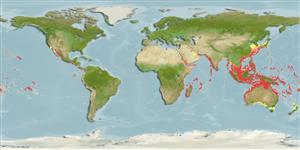Common names from other countries
Environment: milieu / climate zone / depth range / distribution range
Ekologi
Berasosiasi dengan karang; kisaran kedalaman 0 - 133 m (Ref. 100991). Tropical
Indo-Pacific: East and South Africa to eastern Polynesia.
Length at first maturity / Size / Weight / umur
Maturity: Lm ? range ? - ? cm Max length : 9.5 cm SHL jantan/; (Ref. 349); common length : 4.0 cm SHL jantan/; (Ref. 349)
Length based on occurrence record; to be replaced with better reference. Usually found under slabs and small corals (also Ref. 799), frequently occurring in groups (Ref. 349). Also found in shallow subtidal waters (Refs. 349, 2925). Dead shells found on the beaches (Ref. 88739). Members of the family Cypraeidae are primarily carnivores (Ref. 67623).
Life cycle and mating behavior
Kematangan | Reproduksi, perkembang biakan | Pemijahan | telur-telur | Fecundity | Larva
Members of the order Neotaenioglossa are mostly gonochoric and broadcast spawners. Life cycle: Embryos develop into planktonic trocophore larvae and later into juvenile veligers before becoming fully grown adults.
rujukan utama
Acuan | Koordinator | mitra
Poutiers, J.M. 1998. (Ref. 349)
Status IUCN Red List (Ref. 130435)
status CITES (Ref. 108899)
Not Evaluated
Not Evaluated
ancaman kepada manusia
Harmless
penggunaan manusia
Perikanan: komersial
| FishSource |
Alat, peralatan
informasi lanjut
Umur / SaizPertumbuhanpanjang-beratpanjang-panjangMorfologiLarvaKelimpahan
Sumber internet
Estimates based on models
Preferred temperature
(Ref.
115969): 22.5 - 29.1, mean 28 (based on 2376 cells).
keancaman
Low vulnerability (10 of 100).
kategori harga
Unknown.
